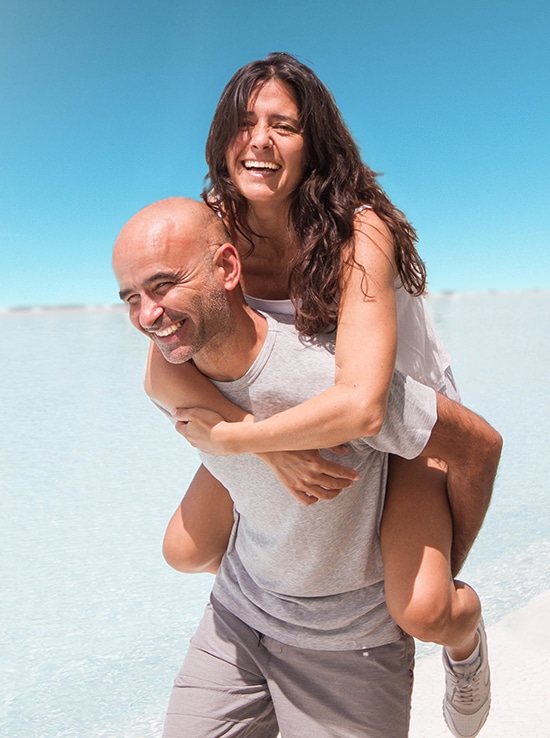Take Back Control of Your Future with TRT
For some men, getting older can be an exciting time where years of hard work culminate into a fun, fruitful transition into retirement. It's a time to cross off bucket-list items and live life to the fullest, without the stress kids or business getting in the way. However, aging is a scary prospect for other men, filled with exhaustion, depression, and inability to perform in the bedroom.
If you're over the age of 40 and have noticed increased irritability and low sex drive, the world is not ending; chances are, you have low testosterone. Fortunately, advances in male health medicine mean you don't have to settle for a lackluster life with low T. If you're among the 39% of men that suffer from hypogonadism, don't lose hope - contact Better Life Age Management Wellness Center to discover the amazing benefits of TRT in Seabrook Island, SC.
At Better Life, we help men just like you decide how they want to address the aging process. Will you settle for a slow decline or enjoy a fulfilling, normal life? If you wait too long, the choice will be made for you, and you might not like the results.
At Better Life, we believe you can influence your genetic potential through lifestyle. Whether you want to keep up with your teenagers on the basketball court or rediscover passion with your partner, our team of testosterone replacement therapy experts can show you the way.
TRT Services
Discover the Best Way to Live a Better Life
Better Life was founded to give men with low testosterone a new lease on life - one that includes less irritability, less body fat, and more energy. If you're ready to look and feel younger, it's time to consider testosterone replacement therapy. Our TRT treatments are safe, effective, and personalized to your body and your goals. That way, you can keep loving life as you age, on your own terms.
For many men, TRT bridges the gap between their old, unsatisfying life and the more vibrant one they experience with hormone therapy. After all, you deserve to be in charge of your health and wellness, especially during middle age and beyond. With Better Life by your side, you have the chance to fight back against low testosterone with tools backed by science and research.
Unlike some other TRT clinics in the Carolinas, we aren't trying to treat our clients like they're on an assembly line. We don't cater to the masses - we help heal men who are serious about reclaiming their lives. Our patients choose Better Life because we:
- Never offer "cookie-cutter" solutions
- Have an unmatched team with decades of experience in a variety of specialties
- Provide personalized TRT services catered to your body and goals
- Take the time to learn about each patient as a person
- Continuously invest our resources into the most scientifically-advanced treatments available
If you're ready to live a more energetic, youthful life, know that it's never too late or too early to do so. But, how do you know you are a candidate for testosterone replacement therapy? Like most things in life, your body will do its part in letting you know.

Symptoms of Low Testosterone
Over the years, researchers have discovered that the prevalence of low testosterone in men increases from about 20% of men older than 60 to 50% of men older than 80.
To make matters worse, about 40% of men with high cholesterol and blood pressure levels also have low T. Additionally, about 50% of obese men experience low testosterone. If you fall into any of these categories, you should begin to think about ways to change your life, like diet, exercise, and TRT.
If you are experiencing any of the following symptoms, it could be time to think about TRT from Better Life:

Erectile Dysfunction
If erectile dysfunction has put a cold blanket over the spark between you and your partner, it's time to make a change. About half of men between 35 and 65 deal with erectile dysfunction and its frustrations daily. Fortunately, at Better Life, we have effective solutions to get you back to a place where spontaneity is welcomed and peak performance is common.
Better Life Carolinas provides the most advanced, non-invasive ED treatments available, like testosterone replacement therapy in Seabrook Island, SC. Our TRT treatments have the potential to correct underlying changes in your body instead of just treating symptoms. We feel this approach is a more realistic option rather than taking a pill every time you need to perform. Check out the reviews on our website - Better Life patients with ED couldn't be happier with our treatments.

Hair Loss
Testosterone has a role in many body functions, including the production of hair follicles. Many men lose hair and begin balding as they age; however, men with low testosterone can also suffer from loss of body hair. While there is an inherited component to balding, you should be wary of hair loss, especially if hair loss is not common in your bloodline.

Increased Body Fat
Let's be honest here: a man's sex life can be thrown into ruin when they get fat. This is especially true when a man has low T and develops symptoms like gynecomastia or large breasts. Of course, getting fatter means you're looking at a litany of new health problems like high cholesterol and diabetes. It seems like middle-aged men just accept the fact that they're going to get fat. But, it doesn't have to be that way. Men who find themselves developing more fat around their stomachs can correct their testosterone imbalance with TRT from Better Life.

Fatigue
Have you noticed that you feel sluggish, tired, or apathetic on your days off? Men with low testosterone have reported lower energy levels and extreme fatigue, even when not working full time. You might have low T if you're constantly tired despite getting eight hours of sleep or more.

Brain Fog
Many men experience changes in concentration, focus, and productivity as they age. Though it's not a serious medical condition, brain fog is usually a symptom of other medical problems, like low testosterone. Men with brain fog experience a lack of mental clarity, problems with memory, lack of focus, and poor concentration. This problem interferes with everyday tasks at work and home, but with hormone therapy, it doesn't have to be an ongoing problem in your life.
How Does TRT Work?
Before we dive into the many benefits of testosterone replacement therapy from Better Life, it's important that you understand how TRT works.
Testosterone was initially lab synthesized way back in 1935. Since then, it has been used in clinical settings to help address low test levels. Over the last couple of decades, testosterone has become one of the most common medications in the U.S.
TRT works by restoring healthy testosterone levels in men that suffer from low T. TRT is not too different from insulin needed by diabetics. Essentially, the body lacks a healthy production of a necessary hormone, so it needs to be "replaced" with an exogenous source - in this case, testosterone.
While most men start taking TRT after 50, more men in their 30s and 40s are having their testosterone levels checked at clinics like Better Life Carolinas. If you think you're "too young" to try testosterone replacement therapy but find yourself suffering from symptoms like ED, it wouldn't hurt to have a doctor measure your T levels.

Benefits of Using TRT
If you're looking for TRT in Seabrook Island, SC, it's easy to understand why. Hundreds of thousands of men have reclaimed their vigor and youth with regular testosterone replacement therapy. With Better Help to guide the way, you too can experience the many benefits of TRT.
Some of the most common benefits that our patients cite include:

Healthier Heart
A healthy heart pumps blood throughout your body, giving organs and muscles the oxygen they need to perform. Testosterone helps red blood cell production through the bone marrow. When you have low T levels, your muscles and organs will often suffer. Low T levels have been attributed to a number of cardiovascular problems, which is cause for concern.
However, a study of 83,000 men found that males whose testosterone levels returned to normal were 36% less likely to experience a stroke 24% less likely to experience a heart attack. This promising sign shows that TRT can actually help keep your heart and blood healthy.

Stronger Bones
Testosterone plays a crucial role in bone density. Bone mineral density decreases as men get older and T levels drop. This drop in testosterone raises the risk of developing osteoporosis. Strong bones help support your organs and muscles, boosting quality of life and even athletic performance. Research shows that bone density increases with higher doses of TRT. Some clinical trials recently found that testosterone also increases hip and spinal bone density.

Increased Libido
One of the most popular reasons why men choose TRT from Better Life Age Management Wellness Center is to enjoy increased libido. Testosterone levels rise in response to sexual activity and arousal. It's well known that men with higher levels of testosterone have more sexual activity. However, older men need more testosterone for healthy erectile function and libido. TRT is often a viable solution for older men who are looking to reignite that special spark with their spouse.
Additional benefits of using TRT can include:
- Less Body Fat
- Better Sleep
- More Confidence
- Better Mood
- More Muscle Mass
- Improved Brain Function
- Better Stress Management
- Lower LDL Levels
- Improved Blood Sugar Regulation
TRT FAQs
What is testosterone?
A: Testosterone is a hormone found in both men and women. Also referred to as an androgen, testosterone is a hormone that helps the formation of male body characteristics. Normal testosterone levels for men are between 300 to 1,010 nanograms per deciliter (ng/dL). As men and women age, they can expect their testosterone levels to decrease naturally. However, conditions like obesity and type 2 diabetes and injuries to the testicles can affect T levels. Whether from natural causes or injury, testosterone levels can become abnormally low in some individuals, which is often when TRT is the most helpful.
Is TRT Safe?
A: Clinical trials show that TRT is both safe and effective for men with hypogonadism and abnormally low levels of testosterone. When prescribed by a doctor, TRT is very safe so long as there are no external risks present. Clinics like Better Life offer comprehensive health plans that include TRT and other revolutionary treatments to improve quality of life. These treatments are only conducted after rigorous testing to ensure treatment is necessary. However, TRT is not for everyone. Generally speaking, testosterone replacement therapy is not a good idea for people with diabetes, prostate cancer, and cardiovascular diseases.
What Forms of TRT Are Available?
A: There are several TRT options on the market today, including injections, gels, implants, pills, and patches. After your free consultation and testing, the Better Life team of doctors and specialists will speak with you about the best options for your unique needs.
Enjoy Custom Care and Personalized Service at Better Life Carolinas
The days of "living with it" are over. Today, we're able to treat most symptoms of low testosterone with non-surgical, pain-free solutions like TRT in Seabrook Island. There's never been a better time to reclaim your life and face the issues preventing you from being the best you.
Better Life offers several customized health plan options catered to your needs. We make it easy to supplement your testosterone treatments with our in-house scans, peptides, pharmaceutical-grade supplements, and IV hydration services. Don't delay - schedule your free consultation today!
 843-737-2597
843-737-2597
Free Consultation
Latest News in Seabrook Island, SC
Hicks: No smooth sailing in the forecast for Seabrook annexation plan
Brian Hickshttps://www.postandcourier.com/opinion/commentary/hicks-no-smooth-sailing-in-the-forecast-for-seabrook-annexation-plan/article_ffc62394-3845-11ee-8d6a-3b05f6c164e7.html
For its first annexation in more than 30 years, Seabrook Island’s Town Council picked a real doozy.Next week, council will likely vote to annex nearly 18 acres on Bohicket Creek — just across from neighboring Kiawah Island’s Town Hall — for a mixed-use development designed around a marina and private yacht club.The details are a tad fuzzy (well, as much as they can be with a 200-page proposal), but public sentiment is not.Nearly 600 residents have expressed concerns about the project’s poten...
For its first annexation in more than 30 years, Seabrook Island’s Town Council picked a real doozy.
Next week, council will likely vote to annex nearly 18 acres on Bohicket Creek — just across from neighboring Kiawah Island’s Town Hall — for a mixed-use development designed around a marina and private yacht club.
The details are a tad fuzzy (well, as much as they can be with a 200-page proposal), but public sentiment is not.
Nearly 600 residents have expressed concerns about the project’s potential environmental, traffic and flooding impact. That’s more than a quarter of the island’s full-time residents.
They’ve made it clear they don’t want this, but feel like no one’s listening.
“The vast majority of people have been opposed to this,” says island resident Paul McLaughlin. “They don’t have to listen to us, but don’t go and ask for our opinion if you don’t listen to the answers. It offers no benefit to us; it’s a private club.”
His frustration is understandable, because a lot of people have valid concerns.
The state already considers that stretch of Bohicket too contaminated for oyster harvesting; the feds say it’s not safe to eat fish caught there. The state turned down similar plans 30 years ago … which is about the last time Seabrook gave any thought to expanding its borders.
McLaughlin notes the developer’s plan may address flooding on the property, but what does it do to the rest of the island?
Residents can’t leverage their usual influence over local officials, several of whom publicly support the plan, because most of them aren’t running for reelection.
It’s sort of a perfect storm — and, on Seabrook, it’s definitely storm season.
Local government is usually the most responsive to local citizens. A couple dozen bicyclists can — and did — derail Charleston’s carefully negotiated plans to redesign downtown’s King Street. But hundreds of well-heeled retirees can’t move the needle?
The island’s planning commission recommended the annexation on a 4-1 vote in July over vocal opposition. Residents get one more chance next week at a public hearing prior to an initial annexation vote, but aren’t optimistic.
They’ll get 30 minutes — three minutes per speaker — to relay their concerns in a room that holds an audience of about 60. That’s pretty standard operating procedure for local governments, but Seabrook residents are livid. The town, they say, has ignored repeated calls for a larger venue and more time.
Seabrook Mayor John Gregg says the developer has held informational meetings with residents for the past year, and when the island got the proposal in June, the town posted all documents online.
He says the alternative meeting venues suggested are all behind Seabrook’s private gate — and council meetings must be accessible to the public. Besides, he says, Town Hall is fitted with equipment to broadcast the meeting to the entire island.
If more people want to speak than time allows, the mayor says, speakers will be chosen by a random number algorithm generator.
That probably won’t make residents, or others, happy. Because this isn’t just some not-in-my-backyard grousing. The Coastal Conservation League, the nonprofit Kiawah Conservancy and various Johns Island advocates have also objected. Even Kiawah has taken an unprecedented stand.
Earlier this month, Kiawah Mayor John D. Labriola and Town Council members sent a letter to Seabrook, publicly opposing the annexation.
“We strongly believe that maintaining the current [urban growth boundary] is critically important to protect the unique Sea Islands ecosystem and the rural character of the land outside the boundary for future generations,” Labriola wrote.
That’s called foreshadowing.
Seabrook Councilwoman Jeri Finke wrote in the most recent issue of The Seabrooker that annexing the land gives the town control over it, which is better than allowing Charleston County or Kiawah to make the decisions. Her argument hasn’t moved many.
That’s because Kiawah Mayor Labriola hit on a salient point. Since the land falls outside the urban growth boundary, its potential development would be fairly limited … if Seabrook just stayed out of this.
See, right now that land falls under county jurisdiction, and County Council would never ignore such a large and influential group of citizens.
But Seabrook’s annexation blocks county intervention because the town isn’t party to the urban growth boundary agreement. That allows a few outgoing public officials to open the door to new development.
The Andell tract, as this land is called, sits at the end of Betsy Kerrison Parkway — an area just outside two wealthy communities under tremendous development pressure. Already, more businesses, a retirement community and an entire medical district are in the works.
But that land was never meant to be developed, at least not to this extent. That’s what the urban growth boundary dictates. The overdevelopment of Maybank Highway was meant as a trade-off to leave the rest of Johns Island largely rural.
Such plans often shrivel when there’s money to be made — this is proof of that. But the marina development could also bring renewed scrutiny to the urban growth boundary and spark radical change ... because people are sick of overdevelopment.
But that’s a story for another day.
At the hyper-local level, Seabrook officials should know their audience ... er, constituents. These are people who know how to get things done. They know how to file lawsuits. And they don’t give up.
So don’t expect next week’s vote to be the last word.
Get a weekly recap of South Carolina opinion and analysis from The Post and Courier in your inbox on Monday evenings.
The 4 Most Snake-Infested Rivers in South Carolina
Alyssa Sheahttps://a-z-animals.com/blog/the-most-snake-infested-rivers-in-south-carolina/
South Carolina is known for its barbecue, warm temperatures, and welcoming beaches. But did you know that it’s home to plenty of different species of snakes? The hot, humid climate, combined with the marshy, wet areas and grasslands that make up the Low Country, make an excellent home for serpents. The Piedmont, the hilly region at the edge of the Blue Ridge Mountains, also contains plenty of snakes. ...
South Carolina is known for its barbecue, warm temperatures, and welcoming beaches. But did you know that it’s home to plenty of different species of snakes? The hot, humid climate, combined with the marshy, wet areas and grasslands that make up the Low Country, make an excellent home for serpents. The Piedmont, the hilly region at the edge of the Blue Ridge Mountains, also contains plenty of snakes. South Carolina has 38 different species of snakes, and they’re all native to the state! Let’s take a look at which rivers are home to the most snakes.
1. The Savannah River
The Savannah River is home to plenty of different species of snake. One dangerous serpent you might find here is the Copperhead. This species is the most venomous snake in the state. You can tell the Copperhead apart from others by its brown hourglass crossbands and over a pinkish or tan-colored background. These snakes enjoy the mountains as well as coastal hardwood floors.
They tend to live in grasslands, rolling pine hills, sandy coasts, and longleaf pine flatwoods. This means you might come across one at any point. The Savannah River, which borders Georgia, is home to these snakes and rat snakes. The black rat snakes have a telltale hint of white along their scales and are found in the mountains and Piedmont regions of central Georgia and South Carolina. You can find yellow rat snakes along the coast, and gray rat snakes tend to live in the Savannah River in Southern South Carolina.
2. The Pee Dee Rivers
The Little Pee Dee and Great Pee Dee rivers are home to the brown watersnakes. They’re various shades of brown with dark brown square blotches and a lighter belly. Though they tend to roam the Pee Dee rivers, you could come across one of these anywhere in the state. They enjoy life in flowing water, so rivers are their favorite spots. They’re very common snakes and are fantastic swimmers! Their bites are known to be especially painful, though they aren’t venomous.
3. The Edisto River
Another harmless snake you might come across is the Garter snake. They’re well-adapted to living around people and can often be found in city parks, as well as suburban lawns and gardens. While it’s rare for them to bite, they will defecate and release a foul smell to defend themselves!
The Edisto River makes its way through a large part of the Lowcountry in South Carolina. Much of it is wet and marshy, making it a great home for serpents. Cottonmouths can also be found in palmetto thickets, pine forests, dune areas, and prairies, as well as slow-moving streams, swamps, marshes, ponds, and rivers. This snake is incredibly dangerous and venomous. They vibrate their tails and expose the white interior of their mouths when they hiss.
4. The Broad River
Besides brown watersnakes, you will likely come across banded and northern watersnakes in the Broad River. You might also see Queen snakes, commonly confused with watersnakes due to similar coloration. Unlike watersnakes, though, these won’t typically bite you! Though banded watersnakes aren’t venomous, they give off an awful stench when threatened. Northern watersnakes make up the majority of these species found here and are often confused with copperheads due to the dark brown or reddish bands and blotches on their backs.
The photo featured at the top of this post is © Michiel de Wit/Shutterstock.com
Discover What the Bible Says About the Euphrates River
The Most Snake-Infested Rivers in Georgia
Share on:
About the Author
I'm a 36-year-old mother of 2 and military wife. I have 2 dogs and a cat that I'm thoroughly obsessed with. When I'm not writing for work, I'm writing as a hobby. You can find me knee deep in a pile of books or way too invested in a video game.
Thank you for reading! Have some feedback for us? Contact the AZ Animals editorial team.
How Audubon South Carolina Protects Their Coastal Birds and the Places They Need
Audubonhttps://www.audubon.org/news/how-audubon-south-carolina-protects-their-coastal-birds-and-places-they-need
With their Shorebird Stewardship program, Audubon South Carolina protects Red Knots, American Oystercatchers, and other birds that find respite on their shores. Published June 01, 2023 Maybe it’s seeing the first rays of sunlight peeking over the horizon while Sanderlings and Willets scamper on the sand sneaking bites to eat, or hearing the calls of Laughing Gulls overhead as Black Skimmers bark in the background—or the fact that I haven’t visited a beach in years—but sunrise at the beach is a magical ex...
With their Shorebird Stewardship program, Audubon South Carolina protects Red Knots, American Oystercatchers, and other birds that find respite on their shores.
Published June 01, 2023
Maybe it’s seeing the first rays of sunlight peeking over the horizon while Sanderlings and Willets scamper on the sand sneaking bites to eat, or hearing the calls of Laughing Gulls overhead as Black Skimmers bark in the background—or the fact that I haven’t visited a beach in years—but sunrise at the beach is a magical experience.
This morning, I’m in Charleston, South Carolina exploring Seabrook Island’s coast with my Audubon colleagues. We’re searching for migrating Red Knots, a shorebird that stops over parts of the Atlantic Coast along its 9,000-mile journey to nest in the Arctic. (You can discover its full migration journey with the Bird Migration Explorer.)
Seabrook Island and its neighbor Kiawah Island are two key beaches that the species relies on for survival. Early May is horseshoe crab spawning season, which means the wet sand along islands nearby is filled with their eggs, and outside of spawning, Seabrook Island is rich with donax clams. Horseshoe crab eggs and donax clams are what sustain the knots as they prepare to fly the remainder of their journey to their breeding grounds.
"We get about 40% of the Red Knot Atlantic Coast population—that’s [over] 17,000 birds—that stop on Seabrook and Kiawah Islands in the springtime,” says Allyssa Zebrowski, Audubon South Carolina’s coastal stewardship coordinator.
Like Red Knots, endangered Piping Plovers use South Carolina beaches to rest and feed through the winter before making their way up north to breed. State-threatened Wilson’s Plovers raise their young here—so do state-threatened Least Terns—and 1/3 of the American Oystercatcher’s population find respite on these shores in the winter.
Human disturbance is one of the greatest threats these birds face along the nearly 3,000 miles of South Carolina’s tidal shorelines, whether that’s people walking through resting flocks or unleashed dogs getting too close to nesting birds. That’s why in 2016 Audubon South Carolina launched its Shorebird Stewardship program to conserve these five vulnerable focal species and other coastal birds by educating people about them.
“What started as a seasonal program led into a year-round need for stewardship,” says Nolan Schillerstrom, Audubon South Carolina’s coastal program associate. “We realized…that it really needed a year-round effort, not only to focus on the non-breeding birds but to continue the momentum from year to year.”
Now, depending on the year, Audubon South Carolina sends volunteers called Shorebird Stewards to 10 to 13 different coastal sites to prevent human disturbance. The stewards undergo training each year to learn more about coastal birds and their behaviors. They also are trained on how to talk to beachgoers to get them to care about the birds. Plus, they help post signs alerting people to birds nesting or resting nearby.
“It’s all about getting out there, watching out for the birds, and telling other people to [be mindful of] the birds,” says Zebrowski.
The Shorebird Stewardship program works with a variety of partners to reduce human disturbance, including Seabrook Island Birders, which runs the volunteer program at their beach site.
We’re joined by a couple of the birders today on our walk to find the Red Knots. Many of the beachgoers they encounter are their neighbors and visitors to the private island, so they have their own way of telling people to look out for the birds.
“I like to tell people a story about the birds to make them feel sympathetic towards them,” says Lesley Gore, one of the program coordinators. “I’ll tell them how many miles the Red Knots are going to fly and that it’s very important for them to gain their weight [undisturbed].”
It’s clear that stewardship plays a vital role in protecting beach birds across the country. A recent study led by Audubon’s science team found that four vulnerable coastal bird species’ populations grew 2 to 34 times faster at stewardship sites rather than birds in only protected areas.
Audubon South Carolina is already seeing positive results from the program. “We do see the improved nesting success of the American Oystercatcher, the Wilson’s Plover, and the Least Tern [at sites we help manage],” says Zebrowski. That nesting success is combined with the program’s growing number of volunteers and increased notoriety each year.
And it’s a good thing too, because shorebirds as a whole are at risk in North America. In fact, the continent’s shorebirds have declined by 70% since the 1970s.
“That’s the stat that we always think of when we’re on the ground,” says Schillerstrom. “We want to tern that around and give these birds a fighting chance here on the beach.”
After passing breeding American Oystercatcher pairs, diving Brown Pelicans, and soaring Osprey, we finally reach an inlet that gives us a view of the Red Knots, though they’re on Kiawah Island today. We watch them huddle en masse on the shoreline, preening and calling.
To be able to capture photos and footage, from a safe distance, we visit Kiawah Island the next day and make another trek in hopes of catching the knots at the right time. At first, we find them across the inlet on Seabrook Island, but suddenly, when the tide rises to the perfect height, the birds flock to the sky, flying back and forth over the water uniformly as they murmurate, creating mesmerizing patterns with their striking orange bellies and mottled gray backs.
They land on our side of the inlet, on Kiawah, and begin running along the shoreline, giving us the perfect opportunity to capture their essence. I watch their activity in awe, knowing that in just a few weeks, they will be making the last leg of their journey up north to breed. It reminds me of why we must all do our part to protect them so that they can exist for future generations.
I’m also reminded of a conversation we had with a shorebird steward volunteer, Nancy Chomel, who we met the day before at Seabrook Island. When asked what makes her passionate about protecting coastal birds, she replies, “In saving the birds, we save ourselves.”
Isn’t that what it’s all about?
To learn more about Audubon South Carolina’s coastal conservation efforts, including how to become a volunteer Shorebird Steward, visit their website.
Explore Charleston's Picturesque Barrier Islands On This Epic Multi-Day Road Trip
AnneMariehttps://www.onlyinyourstate.com/south-carolina/multi-day-road-trip-exploring-charleston-barrier-islands-sc/
Everyone loves Charleston. It’s like the crown jewel of South Carolina, having been voted for 10 straight years by Travel + Leisure readers as the #1 city to visit in the United States and the only one in America included in the top 25 best cities in the world. That’s quite the recognition in the travel industry! And those who have been to Charleston certainly understand its allure. From beautiful sights to delicious restaurants to historical charm and southern hospitality, what’s not to love? Not to mention, there are alwa...
Everyone loves Charleston. It’s like the crown jewel of South Carolina, having been voted for 10 straight years by Travel + Leisure readers as the #1 city to visit in the United States and the only one in America included in the top 25 best cities in the world. That’s quite the recognition in the travel industry! And those who have been to Charleston certainly understand its allure. From beautiful sights to delicious restaurants to historical charm and southern hospitality, what’s not to love? Not to mention, there are always so many fun things to do in Charleston and its surrounding area. We’ve got a fabulous road trip for you to take that will get you a little farther out from downtown when you’re ready to branch out and explore more beyond, specifically, the stunning barrier islands of Charleston.
Advertisement
Advertisement
Advertisement
Advertisement
We only included the inhabited islands in our trip. Morris Island is a sixth barrier island of Charleston that’s uninhabited.
If you’d like to stay on each of the islands overnight, be sure to check on whether or not any of the places you’re looking at have a minimum number of nights required. That may be the case especially if your trip is during peak travel seasons, in such case, you may have to choose one location as your base to explore from.
Have you been to any of Charleston’s barrier islands? Which is your favorite if you’ve been to more than one, and why?
If you’re looking for other fun things to do in Charleston, check out the nighttime award-winning tour where you can see some of the city’s incredible sites while learning some fascinating things about the history of this popular locale!
Some Seabrook Island residents call for cap on short-term rentals
Rey Llerenahttps://www.live5news.com/2021/11/19/some-seabrook-island-residents-call-cap-short-term-rentals/
SEABROOK ISLAND, S.C. (WCSC) - An ongoing battle over short-term rentals is brewing on Seabrook Island, where homeowners say uncontrolled growth of properties is affecting their quality of life.Homeowners Ted Flerlage and Paul McLaughlin said although they do not want to end short-term rentals on the island, the effects of recent growth have prompted them to call for a cap on short-term rentals.“If you come here in July, around July Fourth, as a resident walking out boardwalk one, let’s say, to north beach, there&rs...
SEABROOK ISLAND, S.C. (WCSC) - An ongoing battle over short-term rentals is brewing on Seabrook Island, where homeowners say uncontrolled growth of properties is affecting their quality of life.
Homeowners Ted Flerlage and Paul McLaughlin said although they do not want to end short-term rentals on the island, the effects of recent growth have prompted them to call for a cap on short-term rentals.
“If you come here in July, around July Fourth, as a resident walking out boardwalk one, let’s say, to north beach, there’s no space, and that is a rental issue,” Flerlage, who has lived on the island since March 2020, said. “That is a noise issue. It is a parking issue because every spot on the limited parking area is taken.”
The two homeowners have spearheaded the Preserve Seabrook effort. A letter sent to residents as part of the effort says concerns “center on the uncontrolled growth of short-term rentals, especially on streets where there are many full-time and private residential properties.”
“We aim to retain a reasonable offering of properties that can be rented by guests who love to visit and vacation on our beautiful island, while ensuring Seabrook does not gradually morph into a resort community,” the letter states. “We believe adding a cap on the number of resort properties on Seabrook would protect the unique qualities of our island while allowing revenue generated through rental properties to continue to flow back to the town through state and county accommodation taxes that the renters pay.”
Over 300 residents have signed a petition to cap the number of short-term rentals on the island, according to McLaughlin.
The petition seeks a single question on the Nov. 2, 2021 ballot that asks if voters support:
“Seabrook, when I bought here in 2002 and built our house here in 2009, it was more like ‘Cheers,’” McLaughlin said. “Everybody knew your name. Now, with the influx of 500 rental properties and growing, it’s changed a lot, and the quality of life on the island has changed a lot.”
Seabrook Island Mayor John Gregg said a petition from those calling for a cap has been sent to a committee, which will conduct a factual inquiry and then report to town council with recommendations.
“The object for the ad hoc committee was to identify inquiries of factual matters that could inform council as it considers whether or not it is warranted to do further regulation,” Gregg said.
The mayor added that to operate a short-term rental on the island, homeowners need to have a business license and a permit from the town.
McLaughlin and Flerlage said they welcome the data-driven effort but want more communication from the town and to work with them on a solution.
“Our question to them: What is the tipping point? If 500 isn’t the tipping point, is it 600? Is it 700? Is it 800? So, in the meantime, we need to figure it out,” McLaughlin said. “We need to halt what’s going on. Everybody keeps what they currently have, and we study the problem, and we figure out what the solution would be. We don’t make the problem worse while continuing to study it.”
“These are people who live in South Carolina and vote in South Carolina who live on the island and vote on the island,” Flerlage said. “These are the people who are their direct constituents – the people who vote for the mayor and the town council. It’s more than 300 of those people who signed up, which is nearly as many as who voted for them in the last election on Nov. 2, and in our opinion, there has been no communication and we’ve been getting fairly short-tripped on the issue.”
Copyright 2021 WCSC. All rights reserved.
Disclaimer:


Copyright 2024 by Dr. Mickey Barber's Better Life